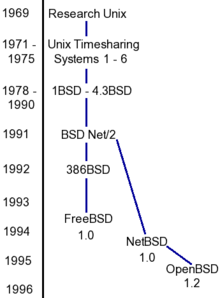Berkeley Software Distribution
 From Citizendium - Reading time: 4 min
From Citizendium - Reading time: 4 min
Berkeley Software Distribution is a derivative of the Unix operating system that was created by and is distributed by the University of California, Berkeley. The first official release of "Berkeley UNIX" was in 1977.[1] Other derivatives of the original 4BSD Unix such as FreeBSD, NetBSD and OpenBSD are also collectively known as "the BSDs." BSD Unix and its derivitives have had a profound influence in the architecture and design of future modern operating systems, from Linux to Mac OS X to Microsoft Windows (especially Windows NT).
History[edit]

note: for more on the history of Unix before Berkeley see the History section of the Unix article
In the early 1970s when Unix was originally being distributed by Bell Labs, the source code was included. This contrasts today with the way proprietary software is sold and distributed - rarely the source code is included, only the compiled binaries are distributed to the public.
In 1974 one common machine was the venerable DEC PDP line of computers. Unix itself had been originally developed on a PDP-7 at Bell Labs,[2] and when Berkeley acquired a PDP-11 it quickly became the first machine to run Unix there. Computers at that time were uncommon, this "working example" was used extensively by the Computer science department for research and development. The "share and share alike" philosophy of Bell labs would serve as the catalyst for the Berkeley campus to soon become a hotbed of activity in the budding world of Unix operating system development. When one of the original creators of Unix (Ken Thompson) taught there during a sabbatical in 1975-1976[1] this also encouraged students at the University to hack away on a brand-new, revolutionary OS (operating system). In time other Computer science departments at other universities became interested in the software being worked on a Berkeley, and so in 1977 the first Berkeley UNIX version (1BSD) was released, from a lab run by a graduate student named Bill Joy. Paralleling the later release of Linux (which ran under GNU's toolset) 1BSD was added on to Sixth Edition Unix, instead of being a full standalone operating system. The later release of 2BSD features Joy's ex line editor (the predecessor to his text editor, vi) and a Pascal compiler.
3BSD was based on Bell Labs' Unix/32V and, like that system, it ran on Digital Equipment's 32-bit VAX machines. However, there were extensive kernel changes and 3BSD was the first Unix to support virtual memory. Around 1980, DARPA funded a large-scale rewrite of the Unix kernel, 4BSD. This was also the first operating system with built-in support for DARPA's TCP/IP protocols, the second generation of protocols used in their ARPANET which was eventually to evolve into the Internet. The prime contractor were BBN, a consulting and contracting firm who had built the original ARPANET, and some work was done at Carnegie Mellon University, but much was also done at Berkeley in a group headed by Joy. There were several distributions based on this; the one that became widespread was 4.2 BSD, released in 1983.
BSD Unix was soon ported to various other architectures, notably the Motorola 68000 processors, and quickly became the standard for the various technical workstation machines that came on the market in the early 80s. Networking is absolutely essential for such applications, so for those vendors BSD's built-in TCP/IP was a huge advantage. One important workstation vendor was Sun Microsystems, with Bill Joy as one of its founders.
4.2 BSD and 4.3, released in 1986, were not standalone systems; you needed Unix source code to build them and an AT&T Unix license, as well as a license from Berkeley, to use them legally. Networking Release One or Net/1, released in 1989, did not require an AT&T license and could be freely redistributed, but it was by no means complete. Basically, it was only a distribution of the Berkeley networking and file system code, without the Unix utilities or much of the rest of the kernel. Net/2, released in 1991, was much more complete, but still not a standalone system.
BSD Today[edit]
Today the most popular examples of BSD Unix are the three 'top tier' descendants:
- FreeBSD started life partially as an outgrowth of the 'Unofficial 386BSD Patchkit'. Having its roots in 386/BSD (incedentally the first version of BSD to run on the Intel 386 processor)[3] FreeBSD is generally known for its performance on the x86 architecture, however it has since branched out to other architectures as well.[4]
- NetBSD, the variant of BSD that is known for its portability. NetBSD carries the repuatation of being able to "run on anything," and its homepage prominently touts "Of course it runs NetBSD."[5]
- OpenBSD is commonly known as one of the most secure releases of Unix to date, due to full code audits the project has done and several important aspects of its design. Also notable are its developers' adherence to proactive security and the operating system's integrated cryptography. OpenBSD's homepage reflects their pride in security: "Only two remote holes in the default install, in more than 10 years!"[6]
A newer variant is DragonFlyBSD, a fork from FreeBSD which aims at a rewrite of the kernel to provide better support for multi-processor machines and for clusters.
BSD Licenses[edit]
See main article: Berkeley Software Distribution licenses
The BSD family of licenses are considered "Permissive licenses," meaning users and developers are granted complete control (almost to the level of being in the public domain) over software that is derived from the original BSD Licensed software.
References[edit]
- ↑ 1.0 1.1 "Origins and History of Unix, 1969-1995" (retrieved 07-April-2007).
- ↑ Dennis M. Ritchie. "The Evolution of the Unix Time-sharing System".
- ↑ "386BSD" (Retrieved 14-April-2007).
- ↑ "About the FreeBSD Project". Retrieved on 2007-04-11.
- ↑ "NetBSD Homepage". Retrieved on 2007-04-12.
- ↑ "OpenBSD Homepage". Retrieved on 007-04-11.
 KSF
KSF